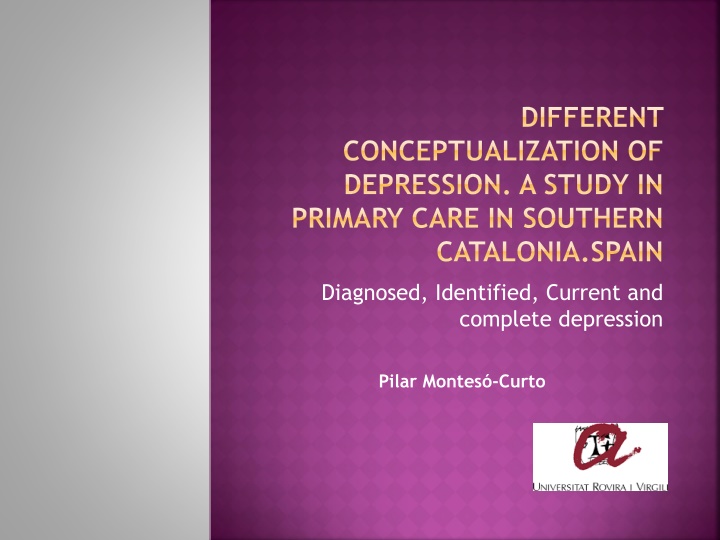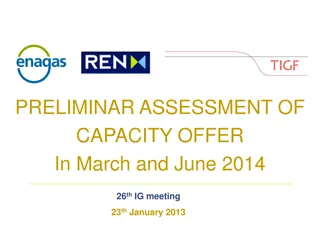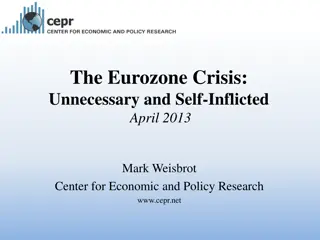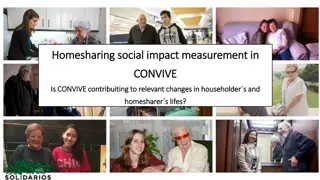
Different Conceptualization of Depression in Southern Catalonia Study
This study in primary care in Southern Catalonia, Spain, explores the diagnosed, identified, current, and complete aspects of depression. It delves into depression characteristics, prevalence in different regions, and the impact on women. The research emphasizes the need for improved recognition and treatment of mental health disorders, particularly depression.
Download Presentation

Please find below an Image/Link to download the presentation.
The content on the website is provided AS IS for your information and personal use only. It may not be sold, licensed, or shared on other websites without obtaining consent from the author. If you encounter any issues during the download, it is possible that the publisher has removed the file from their server.
You are allowed to download the files provided on this website for personal or commercial use, subject to the condition that they are used lawfully. All files are the property of their respective owners.
The content on the website is provided AS IS for your information and personal use only. It may not be sold, licensed, or shared on other websites without obtaining consent from the author.
E N D
Presentation Transcript
DIFFERENT CONCEPTUALIZATION OF DEPRESSION. A STUDY IN PRIMARY CARE IN SOUTHERN CATALONIA.SPAIN Diagnosed, Identified, Current and complete depression Pilar Montes -Curto
THIS ARTICLE IS PART OF DOCTORAL THESIS IN SOCIOLOGY DEPARTMENT SOCIAL TRENDS III Mental Health and Gender: Causes and Consequences of Depression in Women M Pilar Montes Curto Director: Dra. M Violante Mart nez Quintana
INTRODUCTION: DEPRESSION CHARACTERISTICS (I) First Leading cause of SUICIDE Double impact on women causes of illness in 2020 DEPRESSION Suicide leading cause adolescence death Alcohol and drugs: Masked Depression Stigmatized disease
introduction: Depression Characteristics (II) Depression Femininity Female Role dependence dependence Roles acquired through socialization Inherent in the concept of permanence, stability, non-transition Social changes passivity passivity Lack of firmness or assertiveness Lack of firmness or assertiveness No further learn skills such as search, weigh, decide, choose Great need for emotional support Great need for emotional support Role little prestige, no social recognition or financial remuneration DEPRESSION Low self-esteem Low self-esteem Induced to remain in the small and restricted field of possibilities and options Helplessness Helplessness incompetence incompetence
INTRODUCTION In the context of patients accessing primary health care services, the prevalence has shown varying between 10% and 50%. A high prevalence of depressive symptoms was observed among attending a Family Medicine in Mexico City, 52% adult women
INTRODUCTION In USA Dwait 30-40% In Uganda 25.2% In Spain the highest have been found in Gerona, Chocr n 38,8% and Andalusia with 42.0%. V zquez-Barquero in Cantabria 31,5% Fern ndez in Granada 34,7%
INTRODUCTION A high proportion of the population with mental disorders remains and undertreated The severe symptoms are less ignored More frequent depressive symptoms: moderate insomnia, impact at work, anxiety, gastrointestinal symptoms Low prevalence symptoms: suicidal thoughts, weight loss, guilt underdiagnosed
GOALS To distribution by gender and age groups know the prevalence of depression, To identify the different types of depression: Diagnosed, Identified, Current or Goldberg, Total o Full depression
METHODOLOGY Community study in Catalonia Spain Descriptive study stratified by age and sex Sample size: 317 participants (157 women y 160 men) Telephone surveys using Godberg s questionnaire, using systemating sampling
EMPIRICAL RESEARCH EXPLORATORY PHASE Qualitative Phase: 112 patients in-depth interviews - 16 Professional 1- Diagnosed with depression: interviews, questionnaires and TGAD. 6 months- March to July and Sep2007 n=66 (52 W y 14 M). 2- With health problems without a diagnosis of depression: interviews, questionnaires and TGAD. 6 days in September 2007 - n=26 (14W y 12 M) QUANTITATIVE PHASE 6- Study Population. Telephone questionnaire and TGAD. November and December 2007. n= 317 (157 W y 160 M). Statistical analysis
GOLDBERGS DEPRESSION QUESTIONNAIRE ANXIETY SCALE (Score one point for each "Yes") 1. Have you felt keyed up, on edge? 2. Have you been worrying a lot? 3. Have you been irritable? 4. Have you had difficulty relaxing? (If "Yes" to two of the above, go on to ask :) 5. Have you been sleeping poorly? 6. Have you had headaches or neck aches? 7. Have you had any of the following: trembling, tingling, dizzy spells, sweating, frequency, diarrhoea? 8. Have you been worried about your health? 9. Have you had difficulty falling asleep? TOTAL ANXIETY=
GOLDBERGS DEPRESSION QUESTIONNAIRE DEPRESSION SCALE (Score one point for each "Yes") 1. Have you had low energy? 2. Have you had loss of interests? 3. Have you lost confidence in yourself? 4. Have you felt hopeless? (If "Yes" to ANY question, go on to ask:) 5. Have you had difficulty concentrating? 6. Have you lost weight (due to poor appetite)? 7. Have you been waking early? 8. Have you felt slowed up? 9. Have you tended to feel worse in the mornings? TOTAL DEPRESSION=
DEPRESSION DEFINITION Goldberg scale Durkheim Have you been feeling low on energy? Fatigue, Exhaustion Have you lost interest in things? Disappointment Have you lost confidence in yourself? Individuation disintegrated Have you felt hopeless? Hopelessness Anomie, mental and moral confusion Links with collective goals, religion, family and job can help
RESULTS Diagnosed, Identified, Global and Current depression or Goldberg Diagnosed Depression Identified Depression Global Depression Current Depression (n=317) (n=317) (n=317) (n=317) Men (n=160) 29 (18.4%) 34 (21.2%) 63 (39.3%) 64 (40.0%) Mujeres (n=157) 59 (37.5%) 63 (40.1%) 122 (77.7%) 84 (53.5%) Total (n=317) 88 (27.7%) 97 (30.6%) 185 (57.7%) 148 (46.7%)
Results Depression Study Population (I) Men Women Total Underdiagnosed depression, more men than women D. diagnosed 18,1% 36,3% 26,1% D. Identified 21,3% 40,1% 30,6% D.Current or Actual 40% 53,5% 46,7% Infraidentificated Depression, more men than women D.Total 49,4% 66,2% 57,7% Types of depression and gender Increasing age increases depression 200 150 Mujeres 100 Hombre Women had higher depression in age groups 50 0 D.Diagnosticada D.Diag+D.Iden D.Act o Gold D.Total
RESULTS. CAUSES OF DEPRESSION Results Interviews (I) Women Depression Causes Depression Causes Men 60 14 50 12 40 10 8 30 6 20 4 2 10 0 0 Violenc ia Enferm edad estr s trabajo Separa ci n Infanci a Drogas violencia sobrecarga infancia otros 32 34 26 18 mujeres 6 4 6 2 3 3 Hombres 52 52 52 52 total 14 14 14 14 14 14 total Gender Violence Many roles or overload Troubled childhood Education received: Postpartum Depression Low social support
RESULTS Depression according to gender and age groups (years) in a total a 148 individuals Depression Hasta 25a 25-45a 45-65a 65 y m s Total P-valuea 12 33 20 19 84 Women p= 0,684 50% 50,8% 52,6% 63,3% 100% 9 16 17 22 64 Men p= 0,011 37,5% 26,2% 44,7% 59,5% 100% 21 49 37 41 148 TOTAL 14,1% 33,1% 25% 27,7% 100%
Results Depression Study Population (VI) AGE 70% 60% 50% 40% Hombre Mujer 30% 20% 10% 0% Hasta 25a 25-45 45-65 65 y m s
RESULTS Education level and housework variables P-Value Educational level Primary school Secondary school University 54/86 (62.8%) 23/49 (46.9%) 7/22 (31.80%) 0.018 Place of work Women not working outside the home Women working outside the home 43 (75%) 61 (61%) 0.047
Results Depression Study Population n (V) RESULTS Civil Status employment status 80% 80% 60% 60% Hombre Hombres Mujeres 40% 40% Mujer 20% 20% 0% No Trabaja 0% Soltero Si Trabaja Casado-Pareja Separado-Viudo Level of education 70% 60% 50% Hombres Mujeres 40% 30% 20% 10% 0% E.Primarios E.Secundarios E.Universitarios
CONCLUSIONS High rate of depressive symptoms in our community, more especially in women than in men Depression there is much greater than that diagnosed Gender differences in depression begin in adolescence to descend after
CONCLUSIONES The depressions are underdiagnosed and infraidentified for both sexes but higher for men for cultural and social reasons The causes of depression in men are the same as in women Women are medicalized and men are quickly sent to specialists
CONCLUSIONES The majority are moderate depression Higher levels of education and paid work are factors that protect against depression in women.
IMPLICATIONS FOR MENTAL HEALTHCARE The conceptualization of depression from medical or ordinary people point of view may be completely different If indiviuals not always recognize the symptoms, non-psychiatric physicians of primary care health also frequently under- diagnose and under-treat depression






















